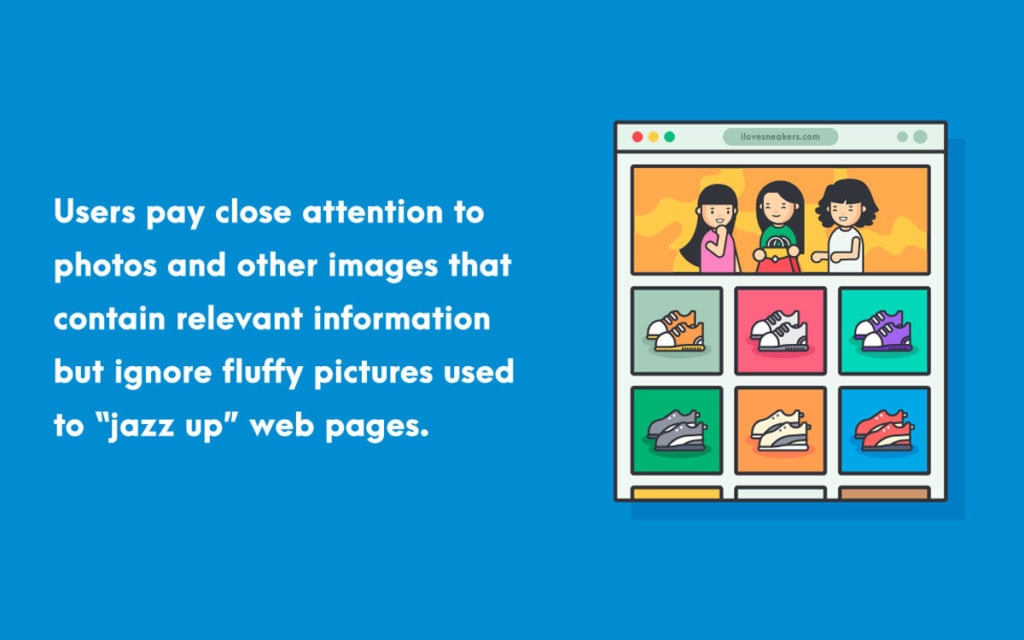Visual Marketing: How to Use Images to Boost Your Brand
Visual marketing is a potent force in digital branding, and as Neil Patel would say, “It's high time you harness its power.” Let's dive deep into the mesmerising realm of visual marketing and discover how to effectively use images to boost your brand's presence and engagement.
In today's fast-paced digital landscape, it's no secret that humans are more drawn to visuals than plain text. That's why, as a savvy marketer, you must embrace the power of visual content to tell your brand's story in a captivating and memorable way. In this all-encompassing guide, we'll explore the latest trends, strategies, and tools that can elevate your visual marketing game to new heights.
We'll dissect the psychology behind why visuals work so well, analyse the types of images that resonate with audiences, and share actionable tips to optimise your visual content for maximum impact. From Instagram-worthy infographics to Pinterest-perfect product photos, we'll teach you how to create eye-catching visuals that attract, engage, and inspire your target audience.
So, whether you're a fledgling entrepreneur or an experienced marketing maven, this article is your go-to resource for understanding and mastering the art of visual marketing. Let's embark on this enthralling journey together and unlock the full potential of images to boost your brand's visibility, credibility, and profitability. Stay tuned because we'll spill all the visual marketing secrets you need to know!
Table of Contents
What is Visual Marketing?

Visual marketing is the art and science of leveraging images, graphics, and videos to promote a product or service, captivating consumers and conveying information in an easily digestible manner. With the rapid growth of social media and visual platforms, visual marketing has become a cornerstone of effective digital marketing strategies. A study by Buffer revealed that visual content is a staggering 40 times more likely to be shared on social media than other content types. Furthermore, research indicates that humans can process visual information an astonishing 60,000 times faster than text, making visual marketing an essential tool for capturing attention and fostering engagement.
Visual marketing encompasses a diverse array of formats, each with its unique strengths and applications. These formats include:
- Images and photographs: High-quality, captivating images can effectively showcase a product, evoke emotions, or set the stage for your brand's story. They can be used across various platforms, from social media to websites and emails, to create an instant connection with your audience.
- Infographics: These visually appealing and informative graphics can break complex information or data into easily digestible, bite-sized pieces. Infographics are an excellent way to communicate critical insights or statistics in a memorable and shareable format.
- Videos: Videos allow for dynamic storytelling and can evoke strong emotions, making them a powerful medium for engaging your target audience. From product demos to testimonials and behind-the-scenes content, videos can provide viewers with an immersive and memorable experience.
- GIFs: These short, looping animations are perfect for adding a touch of fun and personality to your visual marketing efforts. GIFs can convey emotions, highlight product features, or entertain, all while keeping your audience engaged.
- Memes: Using popular culture and humour, memes make your brand more relatable and shareable. Memes can humanise your brand and spark conversations, allowing you to connect with your audience more deeply.
- Slide decks: Slide decks or presentations can be used to share in-depth information or tell a compelling story in a visually appealing format. They are handy for webinars, conferences, or training sessions, where you must convey a large amount of information in an organised manner.
- Interactive presentations: Adding interactivity to your presentations can boost engagement, making your content more memorable and impactful. Incorporating quizzes, polls, or clickable hotspots can enhance the user experience and encourage active participation.
By mastering the art of visual marketing and effectively utilising these various formats, you can create a powerful and engaging brand narrative that resonates with your target audience, driving higher engagement, shares, and conversions.
Images: The Powerhouse of Marketing

Images hold incredible power in the realm of marketing. They can convey emotions, narrate stories, and evoke memories, making them an invaluable asset for any marketing strategy. A study conducted by Brain Rules discovered that when individuals receive information verbally, they're likely to remember a mere 10% of it after three days. However, when a relevant image accompanies the same information, people's retention rate jumps to an impressive 65% three days later.
Emotional Connection and Brand Loyalty
The emotional connection that images can foster is crucial for building brand loyalty. According to a study by MDG Advertising, content featuring relevant images garners 94% more views than content without corresponding photos. Psychology Today highlights that this emotional bond with a brand drives consumer behaviour. When people feel emotionally connected to a brand, they are more inclined to purchase and recommend it to others.
Key Takeaways:
- Images are highly effective for enhancing information retention.
- Relevant images increase content views and engagement.
- Emotional connections fostered by images can boost brand loyalty and consumer recommendations.
By leveraging the power of images in your marketing efforts, you can create lasting impressions, cultivate emotional connections, and ultimately increase the likelihood of repeat and referral customers. Embrace the potential of images to elevate your marketing strategies and strengthen your brand's position in the minds of consumers.
Tips for Using Visual Marketing
Now that we understand the power of visual marketing let's explore some tips for using it effectively:
1 – Use High-quality Images.

To ensure the highest quality images, consider investing in professional photography. Hiring a skilled photographer can help you create stunning, tailor-made visuals that accurately represent your brand and its unique selling points. Professional photography lets you showcase your products or services in the best possible light and create a consistent, polished image across all marketing channels.
Alternatively, high-quality stock images can also serve as an effective solution for enhancing your visual marketing efforts. With countless stock photo websites available, you can find many ideas that cater to your brand's needs and style. When choosing stock images, select relevant, unique, and engaging ones to ensure they effectively convey your brand's message and resonate with your audience.
Key Considerations:
- Image quality directly impacts consumer engagement and brand perception.
- Professional photography offers tailor-made visuals for your brand.
- High-quality stock images can be an effective, budget-friendly alternative.
By focusing on the quality of your images, you can significantly elevate your visual marketing efforts, capturing your audience's attention and creating a lasting impression. Remember, high-quality visuals not only captivate consumers but also contribute to establishing a professional and credible brand image.
2 – Choose Images that are relevant to your brand.
For instance, incorporating images of people exercising, practising mindfulness, or enjoying nutritious meals would be highly appropriate if you're a health and wellness brand. These visuals showcase your brand's essence and create a connection with your audience by reflecting their aspirations, goals, and interests.
Key Points to Remember:
- Ensure your images are relevant to your brand's identity and message.
- Align visuals with your audience's aspirations and interests.
- Use images that showcase your brand's values and benefits.
You can create a cohesive and impactful visual marketing strategy by carefully selecting relevant images for your brand and message. This approach helps reinforce your brand's identity and fosters a deeper connection with your target audience, ultimately driving engagement and conversions. So, always be mindful of your chosen visuals and ensure they accurately represent your brand's core values and offerings.
3 – Use Images to Tell a Story.

Take, for example, using a carefully curated series of images to illustrate how a product is made. By showcasing the different stages of production, you can offer your audience an insightful behind-the-scenes look into your brand's commitment to quality, craftsmanship, and innovation. This visual storytelling approach educates your audience and fosters trust and credibility by demonstrating transparency and attention to detail.
Key Aspects to Consider:
- Utilise images to convey information efficiently and engagingly.
- Craft a visual narrative that highlights your brand's offerings and values.
- Leverage visual storytelling to build trust, credibility, and consumer engagement.
By harnessing the power of images as storytellers, you can create compelling and informative visual content that resonates with your target audience. This approach enables you to convey important information in an easily digestible format while showcasing your brand's unique qualities and expertise. So, don't hesitate to embrace the potential of images to tell your brand's story, engage your audience, and drive meaningful results.
4 – Use Images to Evoke Emotions.
As previously discussed, images possess the remarkable ability to evoke emotions in consumers. By tapping into this potential, you can effectively enhance your visual marketing efforts and establish a solid emotional connection with your audience. One powerful approach is to utilise images that elicit positive emotions, such as joy, excitement, or awe.
Incorporating images that evoke positive emotions can create a more impactful and memorable experience for your audience. These emotions capture attention and help forge an emotional bond between your brand and consumers. This emotional connection, in turn, can influence purchasing decisions and encourage brand loyalty.
For example, an image of a happy family enjoying a product or service can evoke feelings of joy and warmth, while a stunning landscape might inspire awe and admiration. By strategically selecting images that trigger positive emotions, you can effectively engage your audience and create a favourable impression of your brand.
Key Points to Keep in Mind:
- Utilise images that evoke positive emotions to enhance consumer engagement.
- Positive emotions can help forge an emotional bond between your brand and its audience.
- Emotionally-driven visuals can influence purchasing decisions and encourage brand loyalty.
5 – Use Videos to Showcase your Brand.
Videos have emerged as a potent tool in visual marketing. With their unique ability to showcase your brand, narrate a story, or demonstrate a product's functionality, videos offer a dynamic and engaging way to connect with your target audience and convey your message effectively.
Showcasing Your Brand with Compelling Video Content
Leveraging videos in your marketing strategy can help you create an immersive and memorable experience for your audience. By showcasing your brand's unique offerings, values, and personality through creative and captivating video content, you can build a deeper connection with your viewers and foster brand loyalty.
Telling Stories and Demonstrating Product Functionality
Videos are an excellent medium for storytelling and demonstrating how a product works. By visually presenting your product's features, benefits, and practical applications, you can help your audience better understand its value and relevance to their needs. This, in turn, can encourage them to consider purchasing or recommending your product to others.
Additionally, videos can be used to share customer testimonials, behind-the-scenes glimpses, or informative tutorials, further enhancing your brand's credibility and relatability.
Key Takeaways:
- Videos serve as a dynamic and engaging visual marketing tool.
- Video content can showcase your brand, narrate stories, and demonstrate product functionality.
- Videos help build a deeper connection with your audience, fostering brand loyalty and driving conversions.
6 – Use Infographics to Convey Complex Information.
Infographics have emerged as a highly effective tool for presenting complex information in a visually appealing and easily digestible manner. By combining engaging design elements with concise, informative content, infographics can communicate intricate concepts or data to your audience in a way that is both compelling and easy to understand.
Showcasing Statistics, Explaining Processes, and Comparing Data
Infographics offer a versatile format for presenting various types of information. They can effectively showcase statistics, demonstrate processes, or compare data, making them invaluable for your visual marketing strategy. Some critical applications of infographics include:
- Showcasing statistics: Infographics can present critical insights, facts, or figures highlighting your brand's achievements, market trends, or consumer behaviour patterns. By visually representing this data, you can make it more engaging and memorable for your audience.
- Explaining processes: By breaking down intricate functions into simple, visual steps, infographics can help your audience better understand how a product or service works. This, in turn, can foster trust, credibility, and consumer confidence in your brand.
- Comparing data: Infographics are particularly effective for comparing different products, services, or data sets. Presenting this information in a visually appealing format makes it easier for your audience to discern the key differences and make informed decisions.
Key Points to Consider:
- Infographics simplify complex information with engaging visual design.
- They can showcase statistics, explain processes, or compare data.
- Infographics enhance audience understanding, engagement, and retention.
Case Studies
Let's take a look at some case studies that demonstrate the power of visual marketing:
1 – Airbnb
Airbnb uses visual marketing in various ways, from high-quality images of its properties to videos that showcase unique travel experiences. Their Instagram account is an excellent example of effective visual marketing, with pictures and videos that evoke emotions and tell stories.
2 – Dollar Shave Club

Dollar Shave Club is a men's grooming brand with a following for its humorous and relatable marketing campaigns. Their viral video “Our Blades Are F***ing Great” featured their CEO delivering a witty and irreverent pitch that went viral and helped to establish the brand's identity. The video has since garnered over 27 million views on YouTube.
3 – Nike
Nike is a brand that has long been known for its powerful visual marketing campaigns. From its iconic “Just Do It” slogan to its powerful ads featuring athletes and everyday people overcoming obstacles, Nike knows how to use images and videos to evoke emotions and inspire their audience.
Visual Marketing Best Practices

To ensure your visual marketing is effective, here are some best practices to follow:
1 – Consistency
Consistency is vital when it comes to visual marketing. Use a consistent visual style and colour scheme across your marketing materials to create a cohesive brand identity.
2 – Branding
Ensure your visual marketing materials incorporate branding elements, such as logos and brand colours.
3 – Mobile Optimisation
With more and more people accessing content on their mobile devices, optimising your visual marketing materials for mobile viewing is essential.
4 – Call-to-Action
Include a clear call to action in your visual marketing materials to encourage your audience to take the next step.
Conclusion
In today's digital age, visual marketing is more important than ever. Images and videos are powerful tools for capturing your audience's attention, evoking emotions, and building brand loyalty. By following the tips and best practices outlined in this article, you can use visual marketing to boost your brand and connect with your audience meaningfully. Remember, a picture is worth a thousand words, so ensure your visual marketing works for you.
